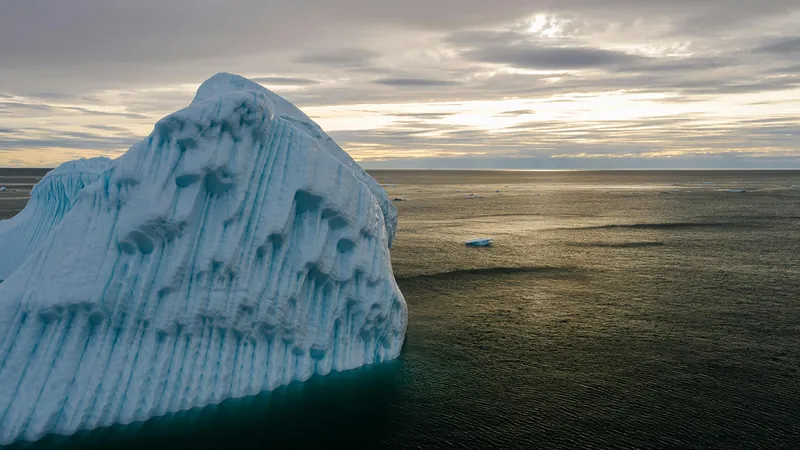
Shocking Discovery: Ancient Algae Upend Arctic Ice Shelf Theory!
2025-08-13
Author: Wei Ling
The Arctic Ice Shelf Debate Heats Up
For over five decades, scientists have wrestled with the theory that a colossal ice shelf—up to a staggering kilometer thick—blanketed the Arctic Ocean during ancient ice ages. This theory suggests a frozen landscape akin to Antarctica's Ross Ice Shelf, but new findings are throwing this long-held belief into chaos.
A Historical Perspective on Ice Ages
Back in the 1970s, British glaciologist John Mercer championed the idea that huge continental ice sheets expanded deep into the Arctic Ocean during periods of extreme cold. By the 1990s, evidence from the seafloor hinted at the presence of thick ice structures, lending credibility to this theory.
New Research Challenges Old Assumptions
However, fresh research published in Science Advances brings a seismic shift to the conversation. The study suggests that instead of a solid ice shelf, the Arctic was characterized more by seasonal sea ice over the last 750,000 years—forever changing our understanding of Arctic climates.
Co-author Gerrit Lohmann, a climate modeler at the Alfred-Wegener-Institut in Germany, stated, "We discovered that even near the Norwegian coast, there was still open water, which completely contradicts the notion of a vast ice shelf covering the Arctic Ocean." Nevertheless, some scientists argue that the new findings might only adjust the timeline and location of past ice shelves, rather than completely dismissing their existence.
Digging Deeper: Ancient Algae's Secrets
This groundbreaking study shifts focus from seafloor scars to examining ancient seafloor sediments. The researchers drilled sediment cores from the Arctic Ocean between Europe and Greenland, investigating the organic materials left behind by marine algae like diatoms and dinoflagellates. These organisms reveal crucial clues about past ice conditions based on their chemical signatures found in sediment layers.
Remarkably, the findings indicated alternating periods of seasonal sea ice and open water—except for a notable 55,000-year window around 676,000 years ago when there was a significant decrease in marine life.
Revolutionizing the Ice Shelf Mystery
While riding home from a funding interview, first author Jochen Knies and Lohmann had an enlightening discussion. Lohmann realized that they could use the high-resolution AWI Earth System Model to glean further insights into Arctic sea ice patterns during the studied era. "The modeling results shocked me; they showed open water even during the coldest periods, contradicting previous hypotheses," he reflected.
Experts Weigh In: The Debate is Far from Over
While not completely dismissing the existence of large Arctic ice shelves, paleoceanographer Johan Nilsson believes the study's findings could redefine their limits. "This pushes the boundaries of possible ice shelves further north of Svalbard," he remarked.
Leonid Polyak, a retired paleoceanographer, affirmed the study's robust data but pointed out that the existence of Arctic ice shelves remains widely accepted. "It’s about the timing and geography of their existence that’s still up for debate," he noted.
Future Implications: A Continual Enigma
As for Lohmann, he admitted that the Arctic still holds many secrets, leaving the pan-Arctic ice shelf debate unresolved. "I feel the final word hasn’t been spoken yet," he concluded, hinting at further exciting research to come.


 Brasil (PT)
Brasil (PT)
 Canada (EN)
Canada (EN)
 Chile (ES)
Chile (ES)
 Česko (CS)
Česko (CS)
 대한민국 (KO)
대한민국 (KO)
 España (ES)
España (ES)
 France (FR)
France (FR)
 Hong Kong (EN)
Hong Kong (EN)
 Italia (IT)
Italia (IT)
 日本 (JA)
日本 (JA)
 Magyarország (HU)
Magyarország (HU)
 Norge (NO)
Norge (NO)
 Polska (PL)
Polska (PL)
 Schweiz (DE)
Schweiz (DE)
 Singapore (EN)
Singapore (EN)
 Sverige (SV)
Sverige (SV)
 Suomi (FI)
Suomi (FI)
 Türkiye (TR)
Türkiye (TR)
 الإمارات العربية المتحدة (AR)
الإمارات العربية المتحدة (AR)